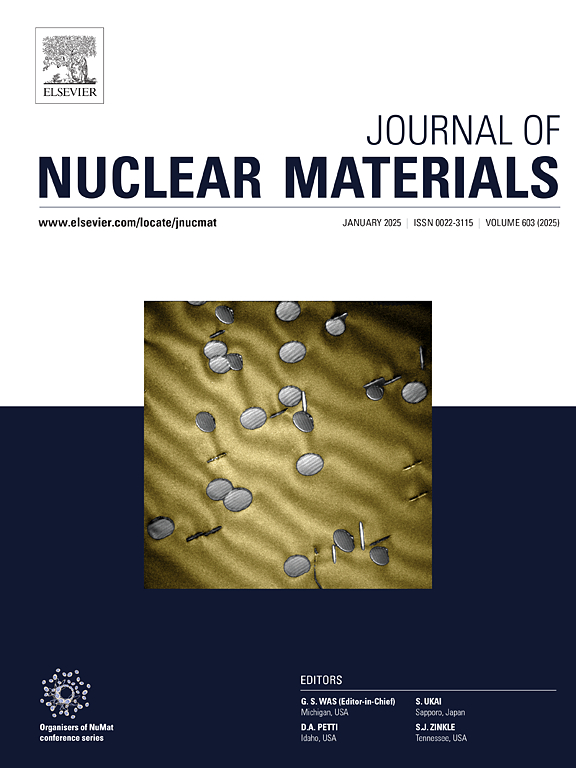Efficient adsorption of radioactive iodine using silver-incorporated bentonite–chitosan hydrogel: Batch and column studies
IF 3.2
2区 工程技术
Q3 MATERIALS SCIENCE, MULTIDISCIPLINARY
引用次数: 0
Abstract
The discharge of radioactive iodine, particularly through nuclear wastewater, poses a persistent environmental threat, which demands effective remediation strategies. In this study, we investigated a novel chitosan-bentonite-silver (CBA) hydrogel designed to efficiently remove radioactive iodine. The bentonite-silver (Ben-Ag) composite was synthesized using a straightforward ion-exchange method and subsequently embedded in a chitosan matrix to form the hydrogel structure. The synthesized CBA hydrogels were systematically characterized using multiple analytical techniques and evaluated for iodide removal performance through batch and continuous column studies. The optimized hydrogel, CBA50, exhibited a notable maximum adsorption capacity of 21.6 mg/g, corresponding best to the Langmuir isotherm model, and kinetic analysis revealed that the data aligned closely with the PSO kinetic model, which suggests a chemisorption-driven adsorption process. Moreover, the hydrogels showed robust adsorption performance across a broad pH spectrum (pH 4–11) and in various anions and cations coexisting environments. Regeneration experiments exhibited considerable removal efficiency over five successive cycles, which highlights the potential reuse of hydrogels. Several removal mechanisms involving precipitation, electrostatic interactions, ion exchange, pore filling, and hydrogen bonding were proposed. These findings suggest that the CBA hydrogels are both efficient and environmentally friendly adsorbents for the removal of radioactive iodine in wastewater.

含银膨润土-壳聚糖水凝胶对放射性碘的高效吸附:间歇和柱状研究
放射性碘的排放,特别是通过核废水排放,对环境构成持续威胁,需要有效的补救策略。在这项研究中,我们研究了一种新型壳聚糖-膨润土-银(CBA)水凝胶,旨在有效去除放射性碘。采用直接离子交换法合成膨润土-银(Ben-Ag)复合材料,并将其包埋在壳聚糖基体中形成水凝胶结构。采用多种分析技术对合成的CBA水凝胶进行了系统表征,并通过批处理和连续柱研究对其除碘性能进行了评价。优化后的水凝胶CBA50的最大吸附容量为21.6 mg/g,符合Langmuir等温线模型,动力学分析结果与PSO动力学模型吻合较好,表明其为化学吸附驱动的吸附过程。此外,水凝胶在广泛的pH谱(pH 4-11)和各种阴离子和阳离子共存的环境中都表现出强大的吸附性能。再生实验显示,在连续五个循环中,水凝胶的去除效率相当高,这突出了水凝胶的再利用潜力。提出了几种去除机制,包括沉淀、静电相互作用、离子交换、孔隙填充和氢键。这些结果表明,CBA水凝胶是一种高效环保的废水中放射性碘的吸附剂。
本文章由计算机程序翻译,如有差异,请以英文原文为准。
求助全文
约1分钟内获得全文
求助全文
来源期刊

Journal of Nuclear Materials
工程技术-材料科学:综合
CiteScore
5.70
自引率
25.80%
发文量
601
审稿时长
63 days
期刊介绍:
The Journal of Nuclear Materials publishes high quality papers in materials research for nuclear applications, primarily fission reactors, fusion reactors, and similar environments including radiation areas of charged particle accelerators. Both original research and critical review papers covering experimental, theoretical, and computational aspects of either fundamental or applied nature are welcome.
The breadth of the field is such that a wide range of processes and properties in the field of materials science and engineering is of interest to the readership, spanning atom-scale processes, microstructures, thermodynamics, mechanical properties, physical properties, and corrosion, for example.
Topics covered by JNM
Fission reactor materials, including fuels, cladding, core structures, pressure vessels, coolant interactions with materials, moderator and control components, fission product behavior.
Materials aspects of the entire fuel cycle.
Materials aspects of the actinides and their compounds.
Performance of nuclear waste materials; materials aspects of the immobilization of wastes.
Fusion reactor materials, including first walls, blankets, insulators and magnets.
Neutron and charged particle radiation effects in materials, including defects, transmutations, microstructures, phase changes and macroscopic properties.
Interaction of plasmas, ion beams, electron beams and electromagnetic radiation with materials relevant to nuclear systems.
 求助内容:
求助内容: 应助结果提醒方式:
应助结果提醒方式:


